What is Walmart Marketplace?
The Walmart marketplace is an online platform where small businesses and well-established brands can sell their products alongside Walmart’s products.
The platform aims to enhance the selling experience for businesses and increase their growth through advanced pricing, catalog management, advertising, standard return policy, fulfillment, and brand management solutions.
How To Sell On Walmart in 7 Easy Steps
Here are 7 easy steps on how to sell on Walmart:
Step 1: Apply to sell on the Walmart marketplace
Make sure you have all the documents needed to allow you to sell on Walmart.
These documents include:
- Business ID or license number
- Supporting documents with your business name and address
- Proof that you’re an experienced online seller
- Products with GTIN/UPC GS1 Company Prefix Numbers
- W8 or W9 tax forms
- Product catalog that complies with Walmart prohibited products policy
Once you ensure your documents are available, create a seller account by visiting marketplace.walmart.com.
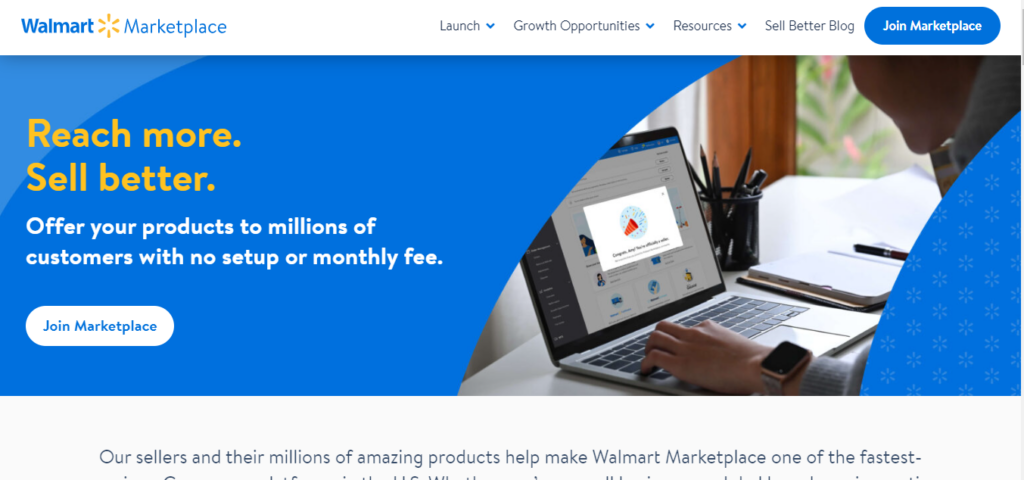
Recently, Walmart opened its Marketplace to international sellers. So, if you’re based outside the U.S., you can still sell on Walmart.
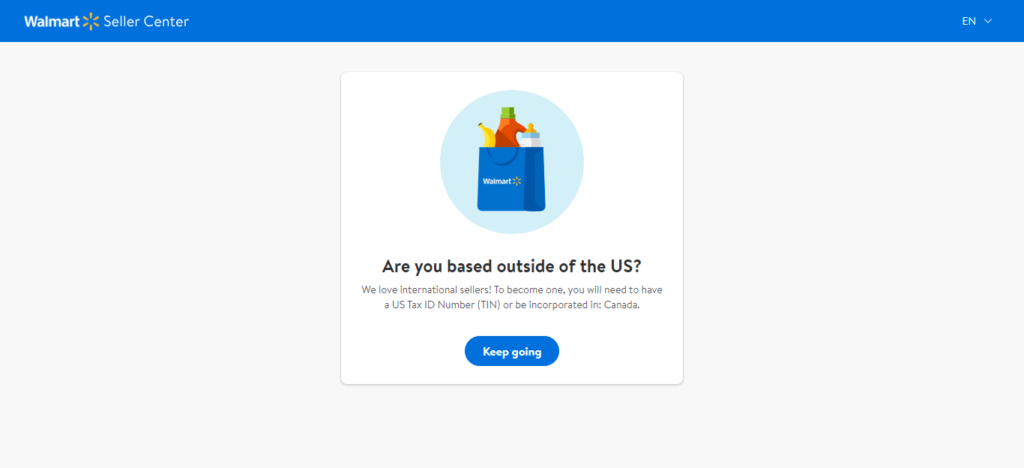
Click ‘Keep going’ and you’ll be brought to a page where you’ll need to type in your details, such as your name, email, phone number, and password.
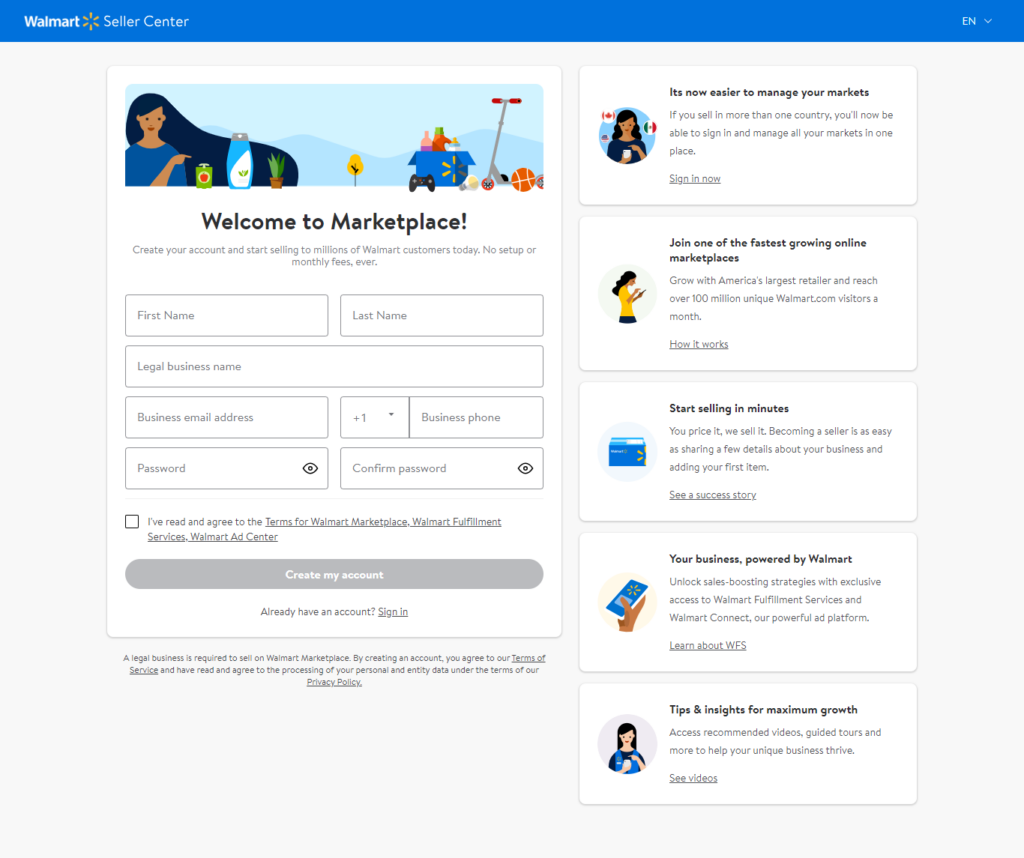
When that is done, read and agree with the terms and conditions. Then, click ‘Create my account’.
You’ll receive an email from Walmart to verify your business email address.
Once your email is verified, log in to your account using your email and password, and you’ll be brought to a page where you can start setting up your account.
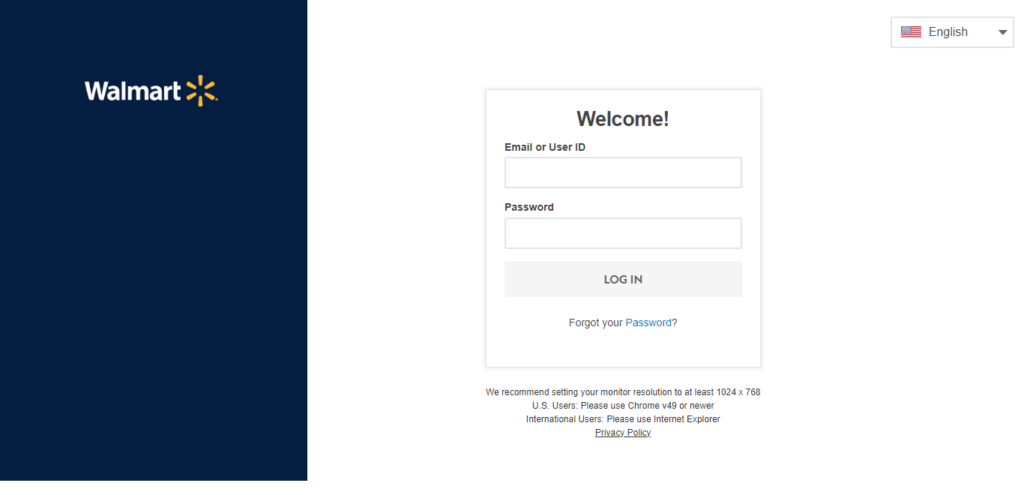
Step 2: Submit business details for verification
Begin to set up your account by verifying your business details. Click ‘Get verified’ to provide your business information.
Ensure you have all your details, including your U.S. tax ID, yearly gross merchandise value (GMV), and your highest-performing category.
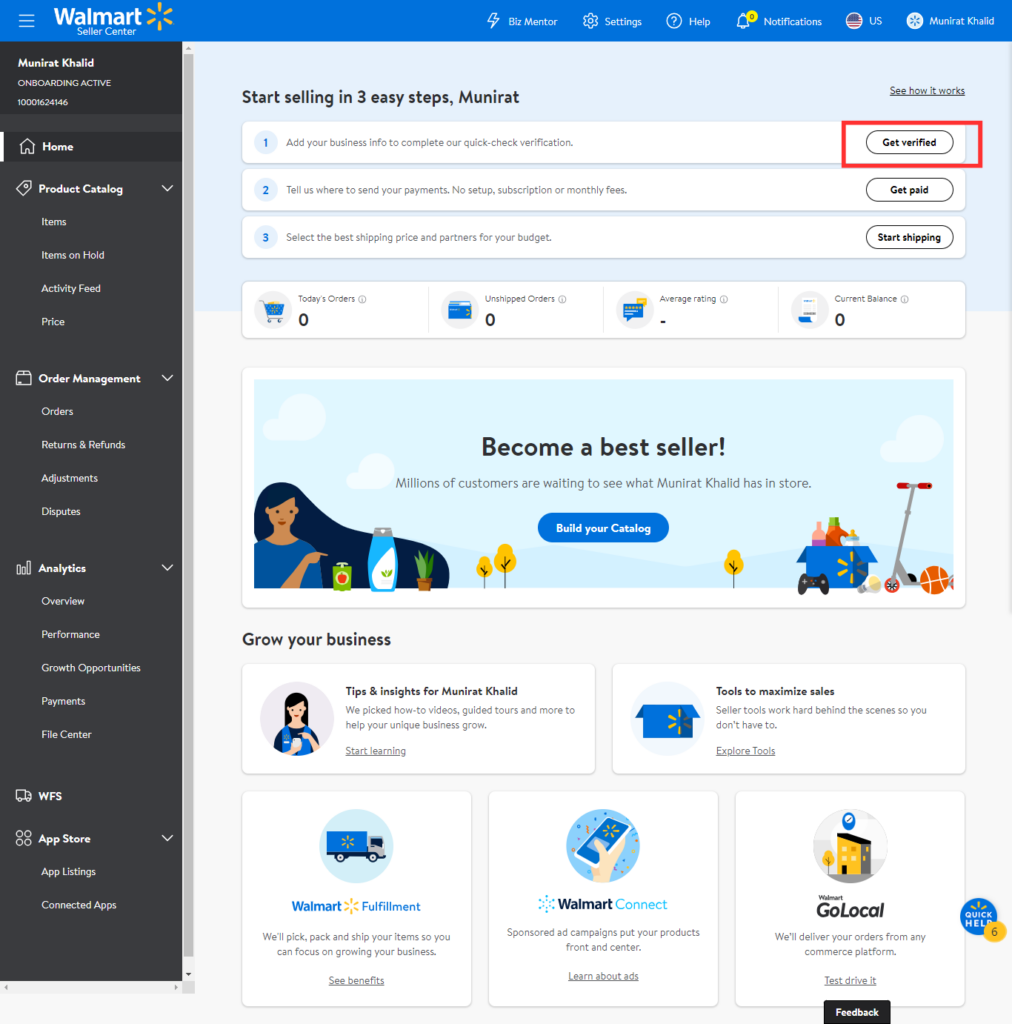
Fill out the verification form with your business information and seller profile details. Click ‘submit for review’, or you can choose to save this form if you’d like to finish it later.
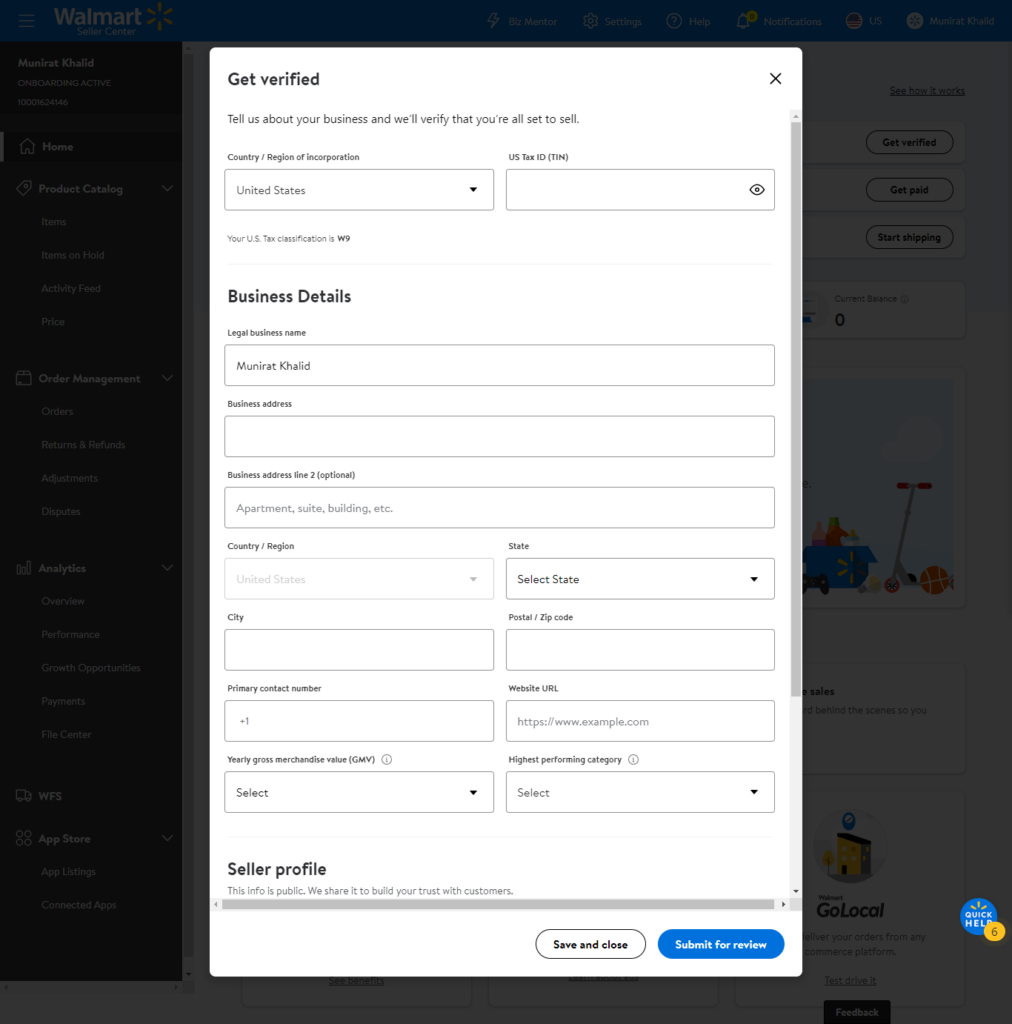
Business verification can take up to two business days. You can check the status of your business verification by visiting the seller application tracking site.
Step 3: Configure your payment method
When your business is verified, set up your payment system. You can choose between the third-party payment methods provided.
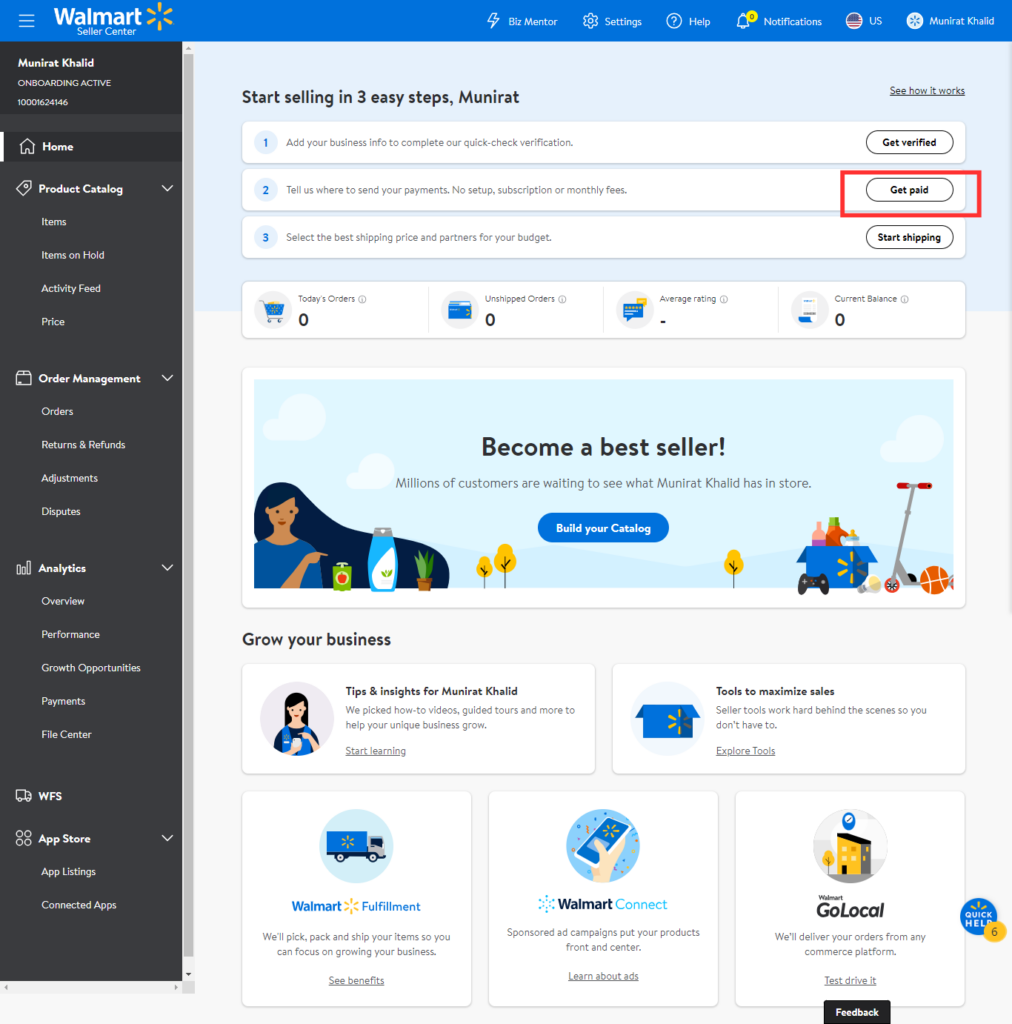
Click ‘Get paid’ to select your preferred payment method and create an account. Alternatively, if you already have an existing account with the payment processor, sign in. Then, follow the guided process to complete your payout setup.
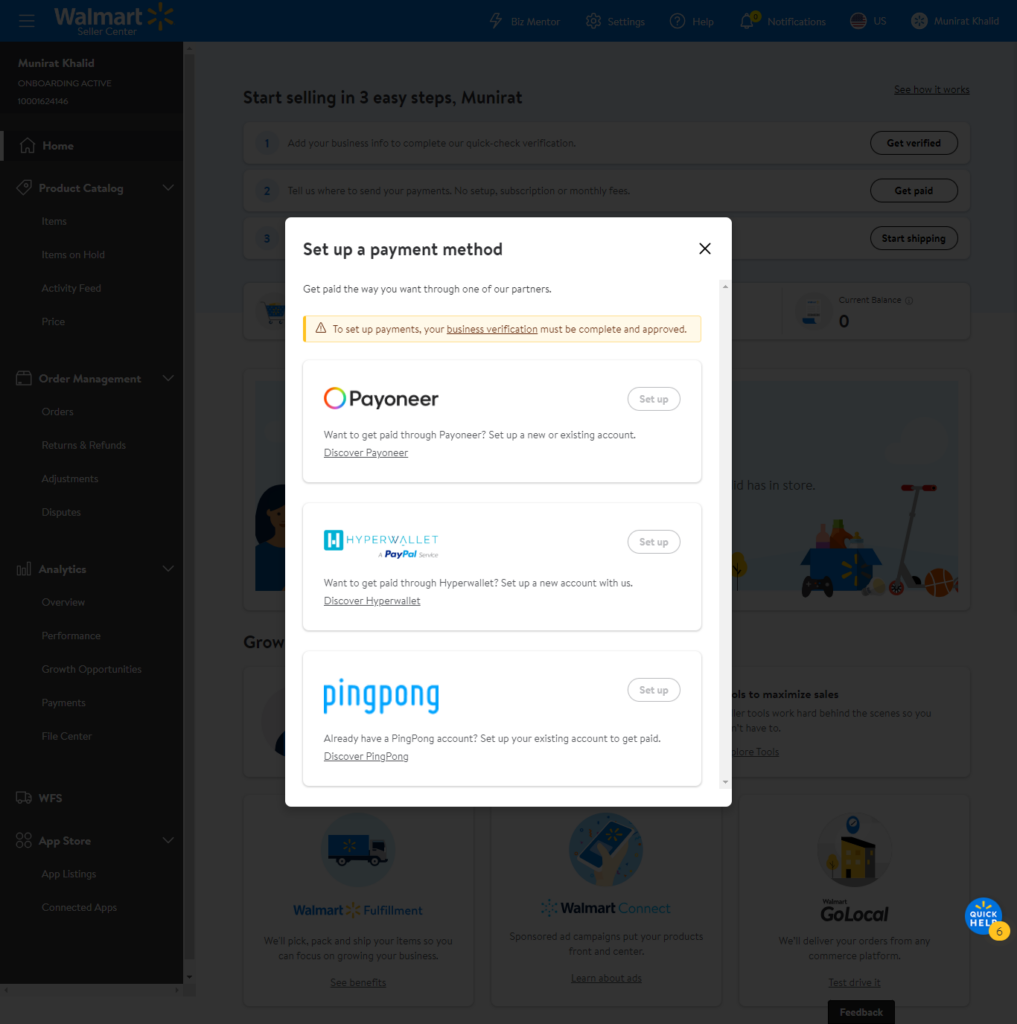
Note: New sellers experience a payment hold of up to 14 days, and international sellers for up to 21 days until they have a credible history of selling on the platform.
Step 4: Set up shipping methods.
Next, set up a shipping and return system you’d like to offer customers who purchase your products.
On the seller home page, click ‘Start shipping’ to select your preferred shipping templates.
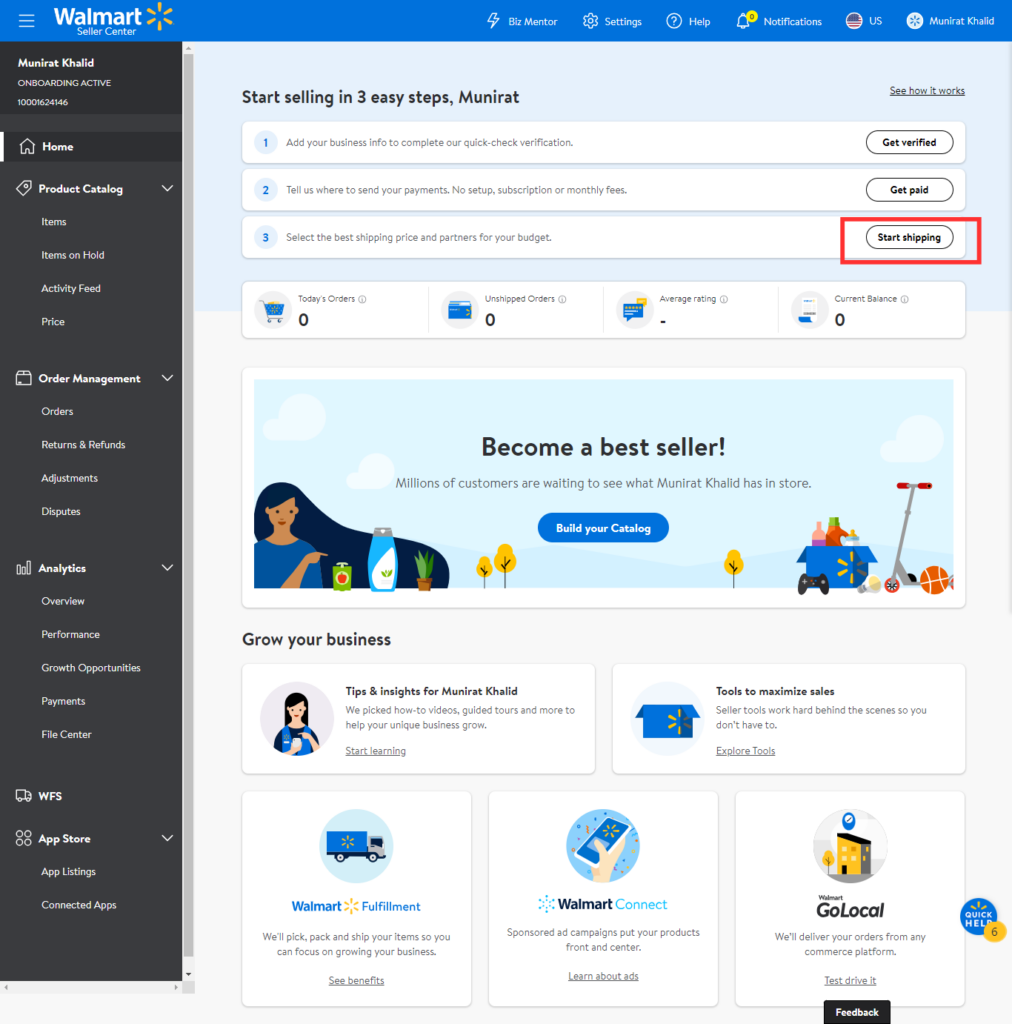
The shipping templates determine how long an order will be fulfilled, the shipping destination, and its costs.
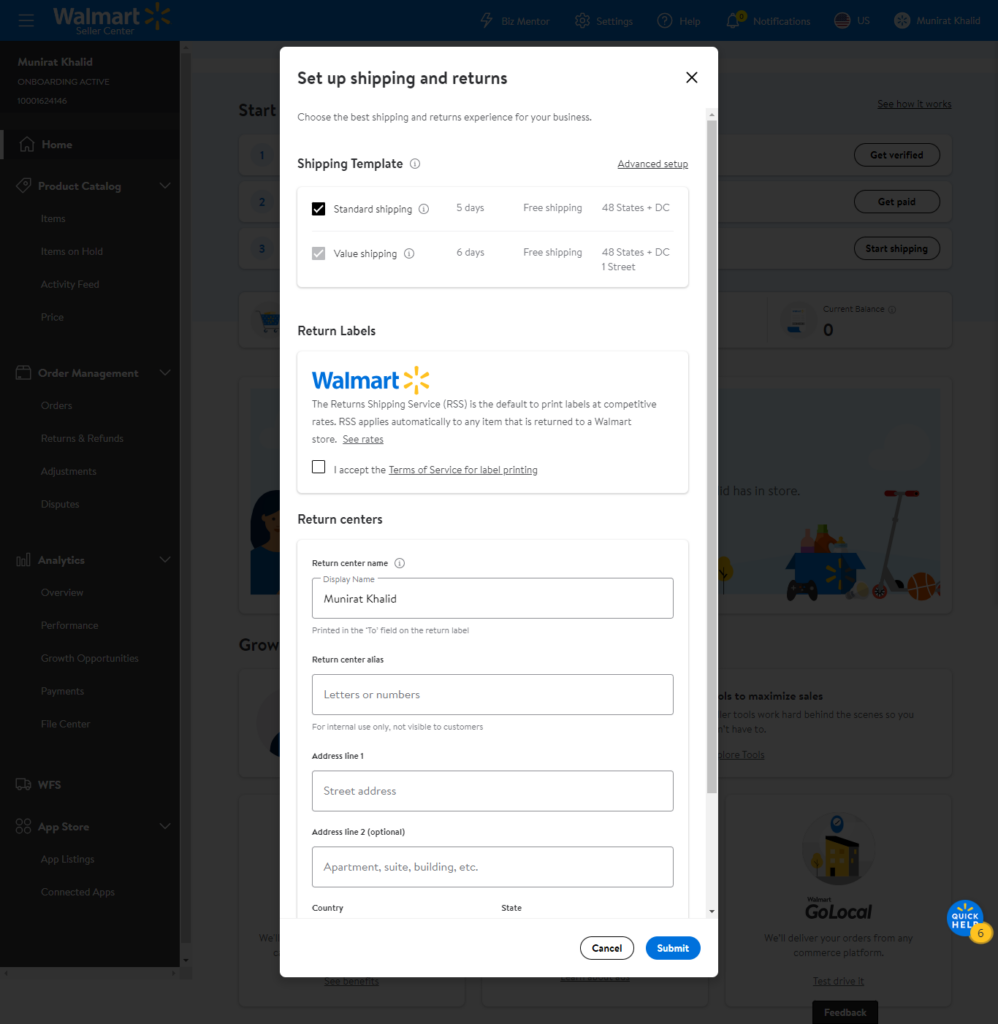
To further customize these options, click ‘Advanced setup’. You can set up your shipping details here, such as the shipping rate model, shipping time zone, region, and transit time.
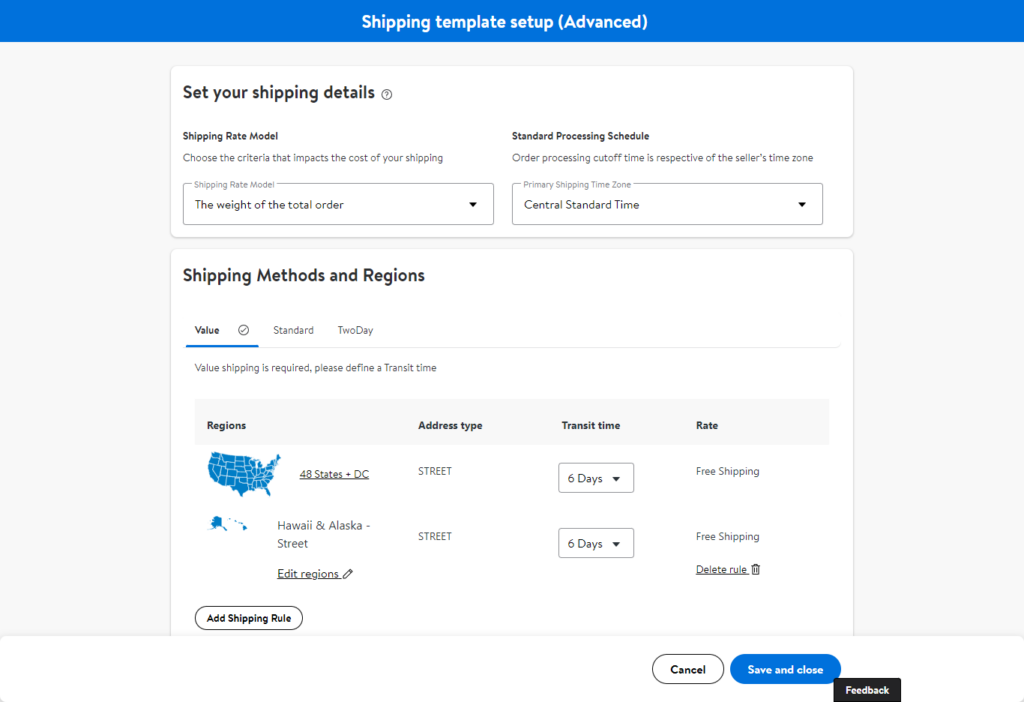
Then, review the return labels and agree to their terms of service.
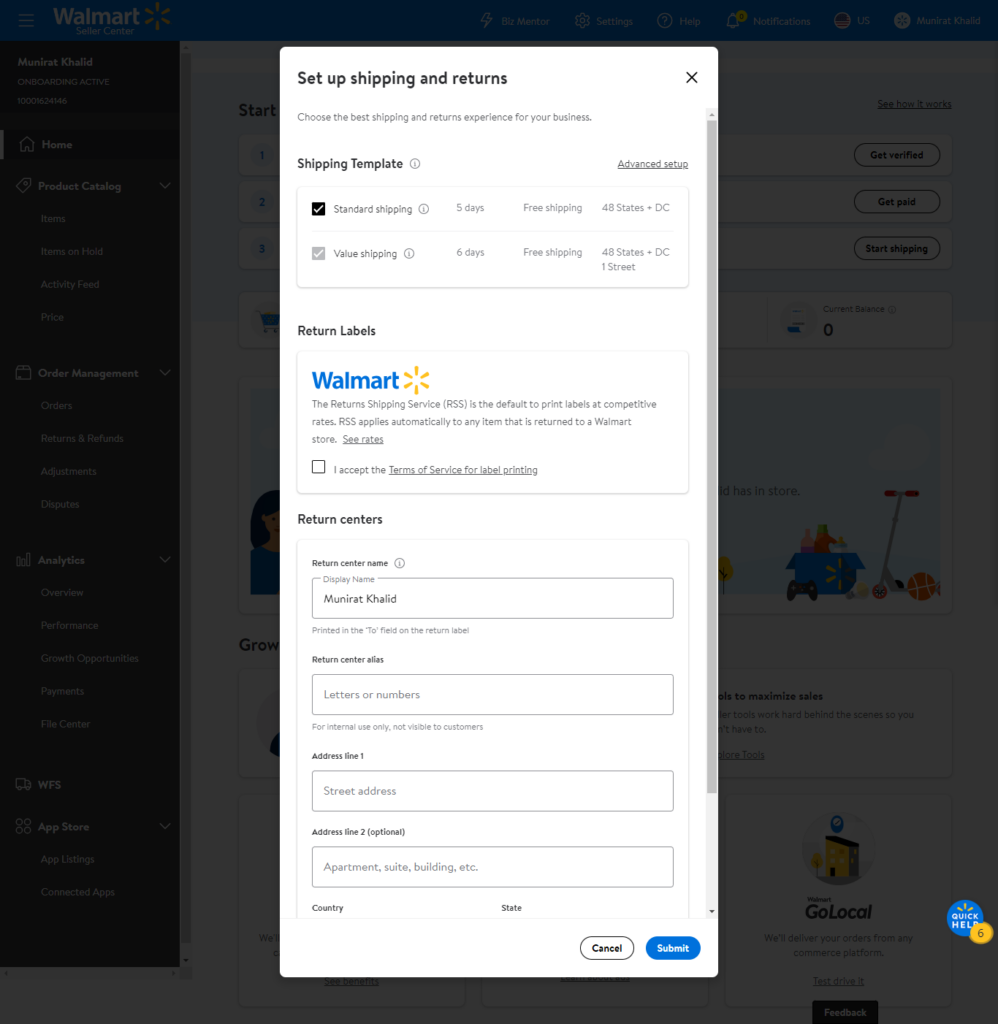
Next, enter your return center details, which will be printed on the return shipping labels. Then click ‘submit’.
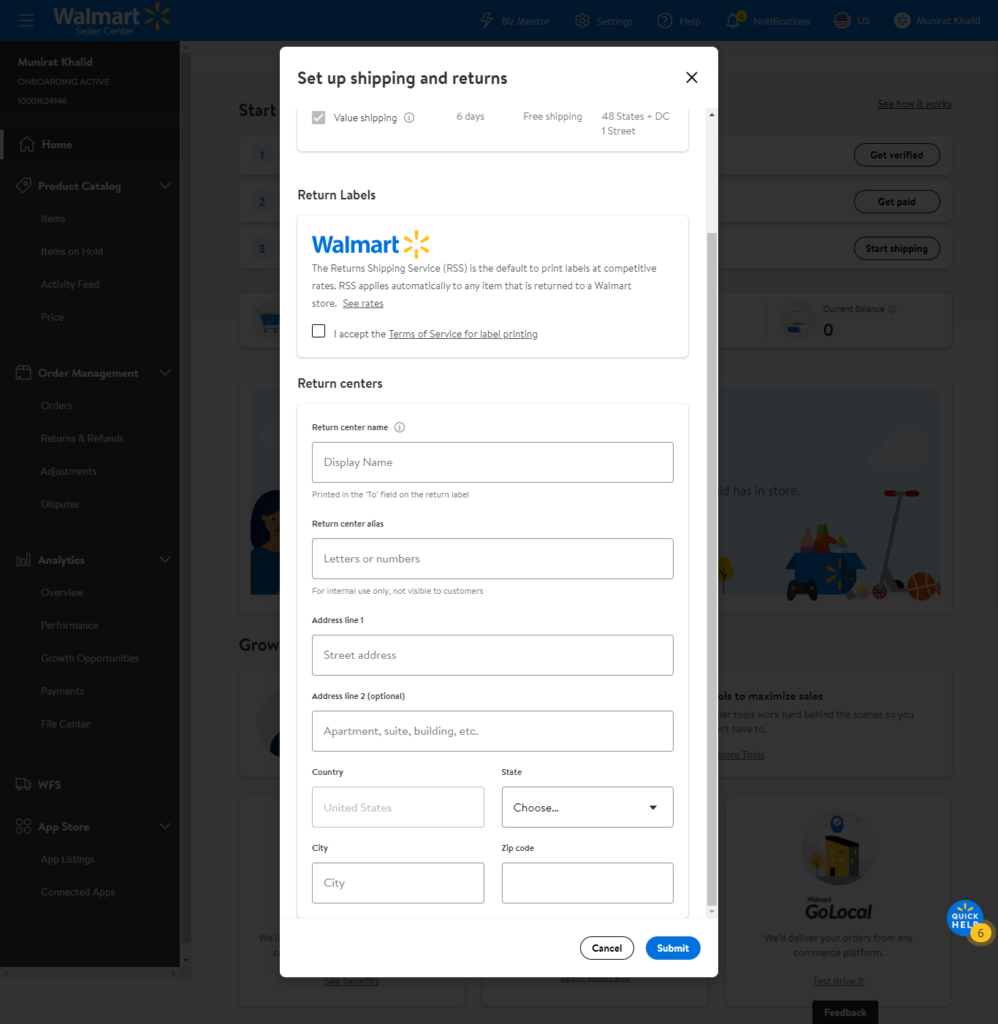
MORE: What is international shipping?
Step 6: Build your product catalog
When your business is verified, payment and shipping methods are all set up, you can start creating your product catalog.
There are three ways to build your product catalog, depending on its size:
- Bulk upload: This method is best for you if you have a large product catalog. With this method, you can upload as many products as possible by importing a spreadsheet that contains a list of your items.
- Single-item method: This method requires you to upload products one by one. It’s suitable for sellers with small catalogs.
- API integration method: The API method helps you generate applications that connect your product catalog on other marketplaces or your website and automatically integrate it with Walmart Marketplace.
Check out Walmart’s guide on item setup to review all options and choose the suitable method for your business.
To add items to your product catalog in bulk:
1. Go to Product Catalog > Items on the left sidebar. Then click ‘Add Items.’
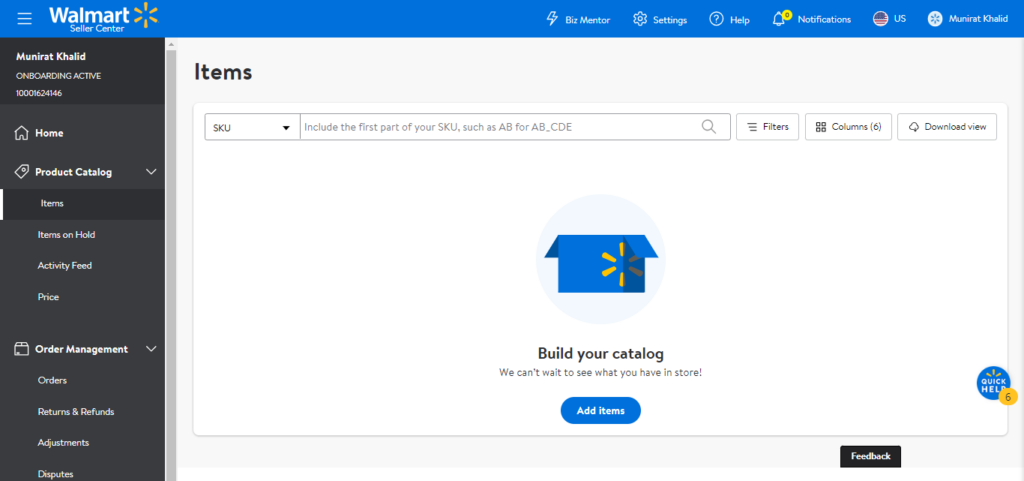
2. Upload your listing report, a customer spreadsheet, or a Walmart template, using the drag-and-drop file upload.
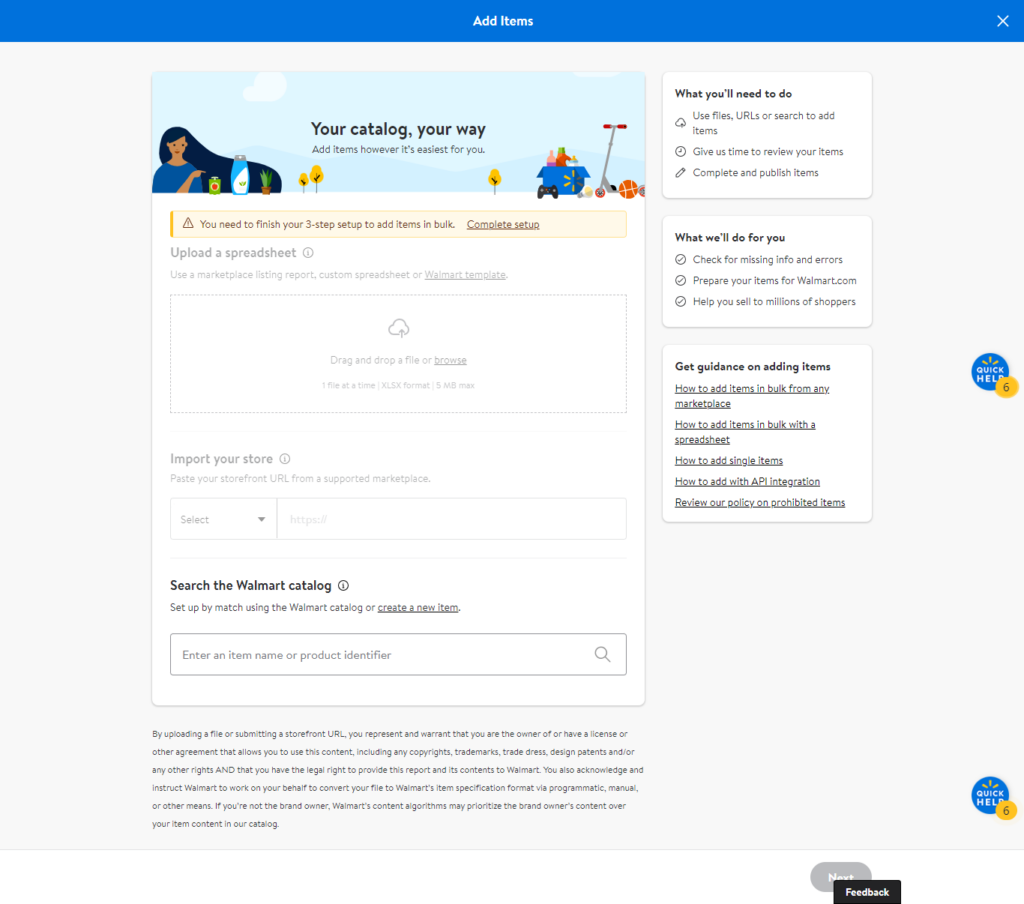
Click ‘Next’ and follow the process to add these items to your product catalog.
To add items individually:
1. Click ‘Add Items,’ then scroll down to ‘Search the Walmart catalog.’ Enter the name of your item in the search field. From the results, begin to add this item to your catalog.
If you don’t find your item in the search results, click ‘Create a new item’ and provide the product details to submit the item for approval.
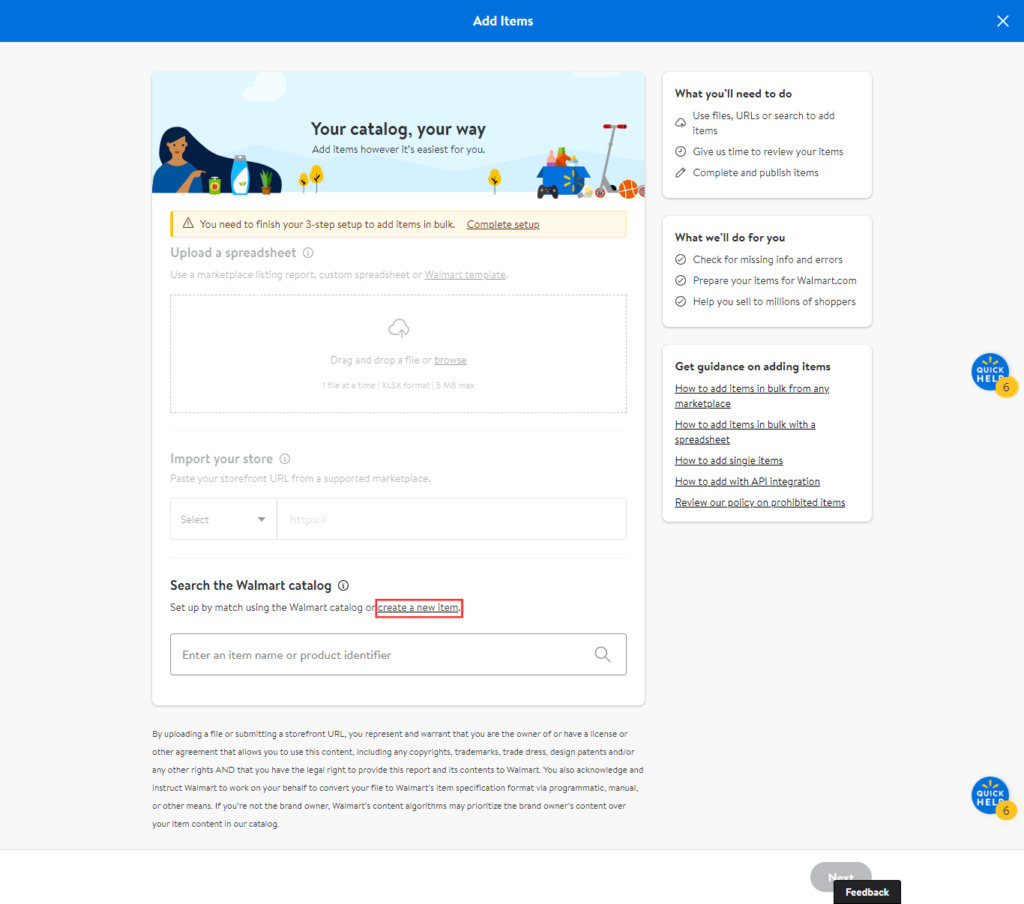
2. Enter the offer details of the product you intend to add to your catalog: the SKU, selling price, fulfillment type, and shipping weight. Then click ‘Submit’.
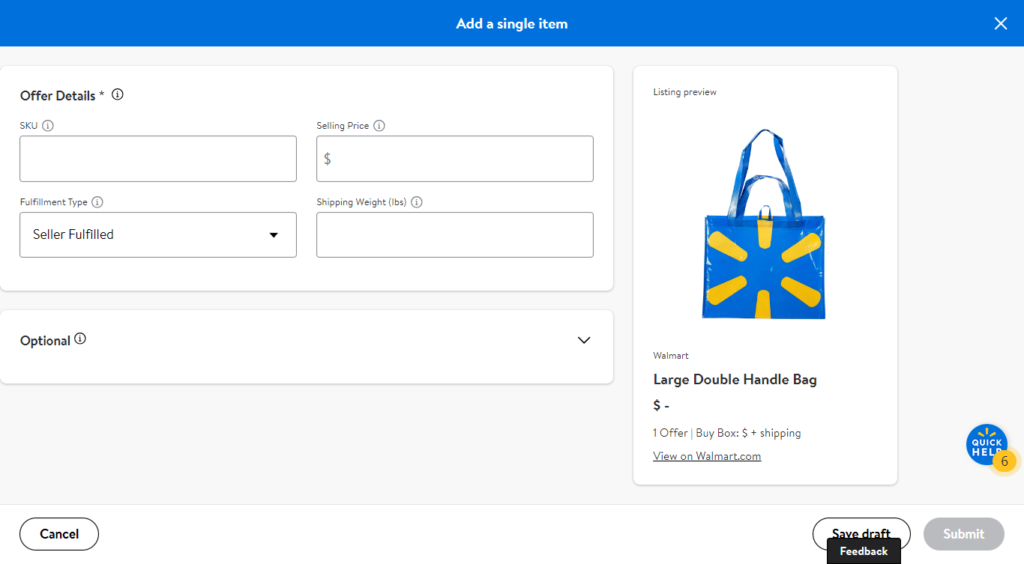
Step 7: Start selling
When you’ve completed the 3-step setup and your items have been uploaded, Walmart will complete a final review on your account before you go live.
Once approved, your items will be published, made open for transactions, and searchable in 24-48 hours.
Why Sell on Walmart?
Walmart.com has a large customer base; the platform attracts 240 million customers weekly and over 500 million monthly visitors.
As a small business owner, you can minimize the cost of paid traffic to your website, as your products will be displayed on a platform that already generates huge traffic.
Walmart owns a market share of 6.4% in e-commerce sales and is the second largest e-commerce platform after Amazon, followed by Apple, eBay, Target, and Costco.
Because it’s a reputable and well-known platform, it’s a great option to increase your brand’s visibility and credibility.
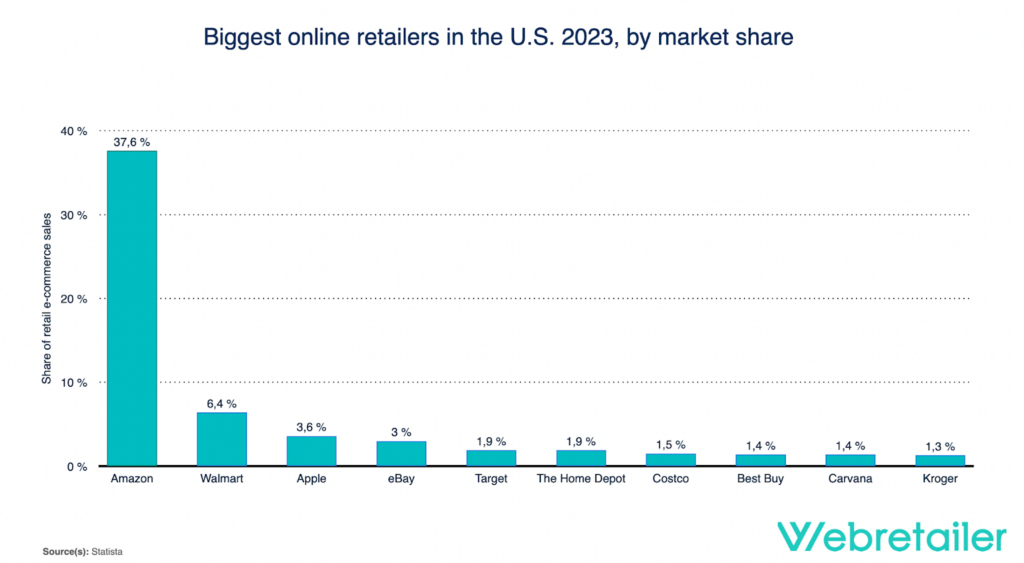
And like Amazon FBA, Walmart also provides fulfillment services where you don’t have to prepare and ship orders to customers by yourself.
Expanding to channels like Walmart helps diversify your revenue streams and reduces the risks of depending on a single platform.
Overall, Walmart is an excellent Marketplace for businesses:
- Looking to expand their sales channels,
- Reach a new audience,
- Make more sales,
- and grow their business.
Pros for Selling on Walmart Marketplace
Less competition
Walmart has about 150,000 sellers on the platform, compared to Amazon, which has over 6.2 million sellers.
This means less competition for you, as consumers are more likely to find and purchase your products than other saturated marketplaces.
Cost-effective
Unlike Amazon, Walmart does not charge listing or monthly fees to sell your products. They only charge a referral fee on products sold, making it a cost-effective option for selling online.
However, the fees vary based on product type. It is usually within a 5% to 20% range.
Easy to run
Walmart is a secure platform and an advanced system that enables you to run your online business smoothly.
You don’t have to worry about site security, maintenance, order fulfilment, returns or other hassles in running an online business.
MORE: eBay vs Amazon
Cons for Selling on Walmart Marketplace
Strict seller requirements
Walmart has strict seller requirements, making it difficult for amateur sellers to sell on the platform, as it requires experienced sellers with a history of eCommerce success or activity on other marketplaces.
Limited product requirements
Walmart has limited product requirements, which means some sellers may be unable to use their fulfillment service due to the size, weight, and other restrictions of the products they wish to sell.
Limited access to fulfillment services
Unlike Amazon FBA, which provides fulfillment services to anyone, Walmart fulfillment service is only accessible to experienced sellers. It could be challenging for newbie sellers, as they’d be responsible for managing inventory and handling complex order fulfillments.
Qualifications to Sell on Walmart
Even though Walmart provides third-party sellers with many opportunities to sell on its marketplace, the company is committed to protecting its reputation and the trust of its customers.
So, if you’re considering joining the Walmart marketplace, here are a few requirements to be approved as a Walmart seller.
1. You need a business ID or license number (SSN is not accepted),
2. You need supporting documents to verify your business name and address,
3. Proof that you’re an experienced online seller and you’ve sold products on other marketplaces or eCommerce platforms,
4. Your products must have GTIN/UPC GS1 Company Prefix Numbers,
5. A catalog with products that do not conflict with the Walmart Prohibited Products Policy,
6. You need to prove that your business can provide exceptional order fulfilment, process returns, or partner with Walmart fulfillment services to do it on your behalf.
Best Tips and Practices to Be a Successful Walmart Seller
After uploading items and going live on the Walmart marketplace, some work needs to be done to ensure your business is set up for success.
Here are the best practices to succeed as a Walmart seller.
1. Test products before launch
Before you launch your products, preview and test at least 2-3 products from your catalog.
When you preview your products, try placing an order and test the following:
- Order shipments,
- Order cancellations,
- Order adjustments,
- Order confirmation,
- Order refund.
Doing this will allow you to see potential errors that might be stressful to live customers and help you make adjustments.
2. Optimize your product listings
A good product listing can be a game changer for any online seller or eCommerce website.
An optimized product listing increases the likelihood of your product being seen by customers and significantly impacts your sales results.
To know how effective your product listings are, use the Walmart Marketplace Listing Quality Dashboard to help improve your product listings for better results.
The dashboard guides you through four factors that help increase the potential of your product listings, these factors include content, discoverability, offer, and post-purchase quality.
3. Win the Buy Box
The Walmart buy box is a product page ‘Add to cart’ or ‘Buy Now’ section.
It contains product details, seller’s information, and other seller’s options.
Sellers of the same item on Walmart.com share a product page and compete for placement in the customer’s buy box.
So the term ‘Win the Buy Box’ requires Walmart sellers to use strategies that increase their chances of ranking first in the ‘Buy Box.’
Whoever ranks first in the buy box gets the sale.
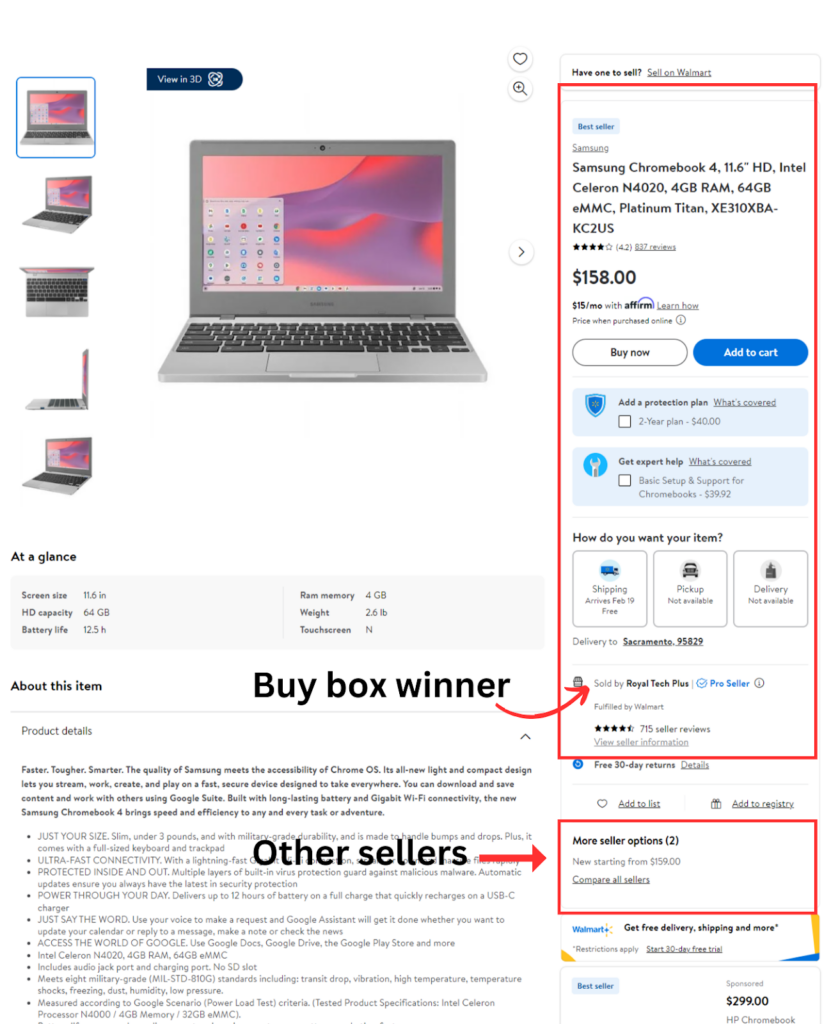
Here are some tips to help you win the buy box:
- Always keep your product in stock,
- Offer free shipping on your product,
- Use competitive and strategic pricing rates,
- Ensure you have accurate product listing information.
MORE: How to start dropshipping business
4. Run Walmart performance ads
You can run sponsored search ads on the Walmart marketplace to help you reach customers who are interested in products like yours.
Walmart allows you to advertise your products throughout the platform using the pay-per-click model.
This means you only pay when customers click on your ad.
Additionally, it allows for precise targeting, budget management, and keyword bidding, making it a cost-effective advertising option.
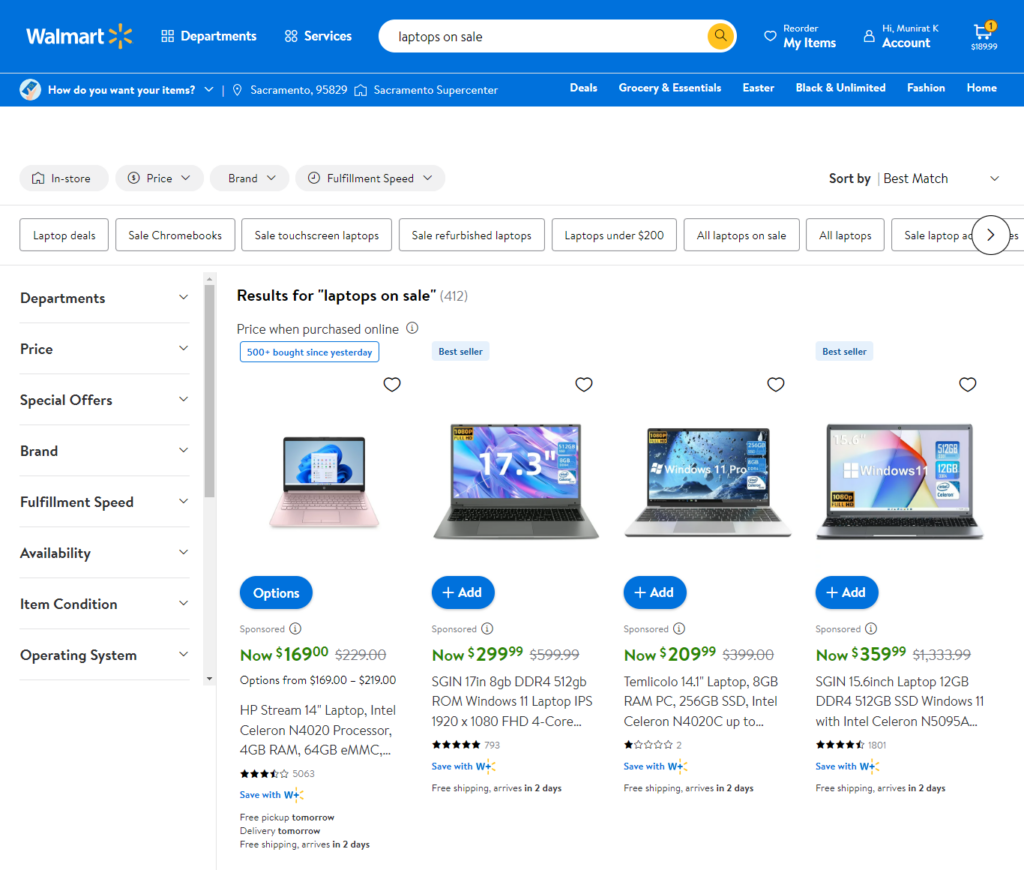
5. Optimize your product listings for search
To successfully sell on Walmart, optimizing your product listing for search is essential.
The first thing buyers do when they think of a product they want to buy, is to go online and SEARCH.
SEO is a crucial factor that converts an individual casually browsing on the platform into a paying customer.
For example, if your brand sells kitchen utensils, you want to include this keyword in your product title, description and images that buyers use to describe your product.
To discover what keywords customers use to describe your product when searching:
- Go to Walmart.com,
- Type in the word used to describe your product,
- Check autocomplete suggestions for more specific keywords.
In a practical example below, you can see the autocomplete suggestions. The keywords that appear boldly are more specific keywords.
So rather than using the generic keyword ‘kitchen utensils’ in your product details, you want to include the keywords that appear in bold to be more specific.
This way, your product appears on the first page of the user’s search results, making you reach more customers.
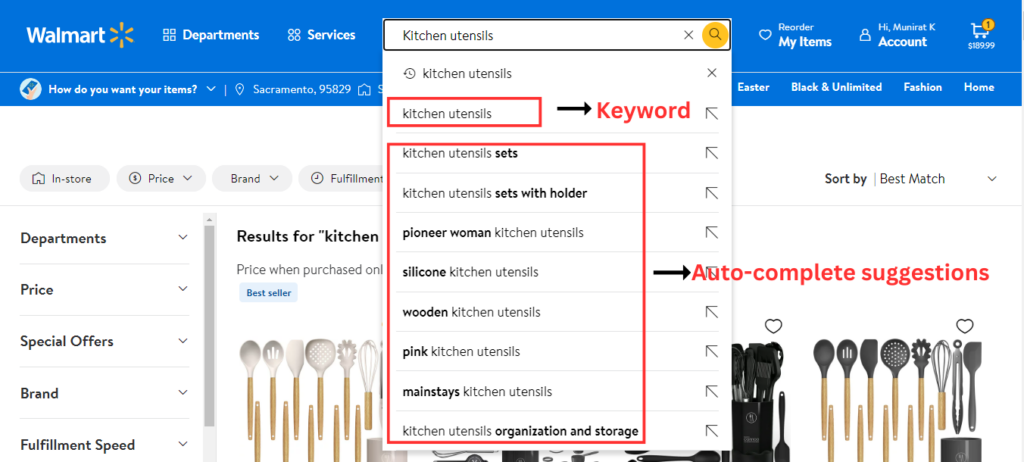
Key Takeaways
Overall, Walmart Marketplace is a great platform for large and small-scale businesses looking to expand their reach and generate consistent revenue growth.
However, one must implement some strategies to succeed as a Walmart seller.
Sellers who offer competitive prices, great fulfillment services, and follow Walmart marketplace guidelines throughout the onboarding process can benefit from Walmart’s large customer base.
With this guide, you can navigate the onboarding process and set your business up for massive success.

Hi, am intested in selling my products on Walmart marketplace. My question is ,can I use partnership registration business to apply with Walmart or cooperative registration?thanks.